
Remodled athletic entrance honors past, looks to future
SARAH HORAN ‘23
School Editor
It might not be the Crisler Center, but Greenhills is taking strides to create a facelift not only to update part of the building but to honor the past, present, and future of all 15 varsity sports. As trophy cases got ushered out of the athletic entrance hallway, they were replaced with large murals to honor the athletes.
to bring home over the years.”
Not only does Greenhills want to honor the past competitors, Shaw said, but there are additional aspects of flexibility for the athletics to come.
were necessary to honor current competitors and to signal to other competitors that walk through the door what our athletic department is really about.
“This is going to have a big and bold visual impact and will give more of an impression as you walk in,” said athletic director Meg Seng. “You will still be able to see the trophies above, and with removing the trophy cases from the hallway, it makes the space more flexible for everyone.”

Over the last five years, Greenhills has been able to bring home nine district championships, 14 regional championships, and five state championships. The goal for the renovation was to both display these recent accomplishments, and to motivate future sports teams.
“For a long time, there was this false notion that Greenhills was all academics and that athletics was secondary, but I believe that anyone at Greenhills knows that athletics and overall health and wellness are a part of learning here as a whole.”
With the exponential growth of high school sports participation and an increasing trophy collection, it was necessary for change.
“The starting point [for the renovations] was the shelves, the two 80-foot shelves that are running along the sides of the hallway,” said Shaw. “Those being able to display more of a timeline of the athletic program, with how many trophies we have been able
“By taking the trophies out of their cases and being able to display them on the shelves chronologically, instead of by sport, when you walk into space you are able to admire the trophies and see all the hard work over the years. It also becomes a flexible space, we are able to shift them to accommodate the new trophies as well.”
The results of this renovation ensure one of the many core values of the school. It will ensure every trophy is properly honored and has a proper home, to not only enhance but revive the former dark entrance.

This led to a search for a way to better appreciate not only the space that is the athletic entrance hallway, but to implement the appreciation of how far each has made it.
After some consideration, it was determined that the renovations
Due to the quick remodel of the hallway, students are slowly discovering the re-design. It has become a seamlessly integrated part of the school community that future generations will be able to admire. “It looks really nice, it makes the space more interesting, there’s more of a history so that students who are playing on current teams and the students that will play on future teams can look back at all the accomplishments that past teams have done, and see the history that they’re standing on,” said Dominic Schuster ‘24.
Little Free Library craze comes to Greenhills Drive
ZARA MIAN ‘25 School Staff
Joining the global trend of outdoor little free libraries popping up on street corners, a new mini library has been installed near the school’s main street entrance as a convenient way to share books with the community.
“One of the things that I really wanted to do was to share books with members of our community,” said librarian Stefanie Halliday. “There are a lot of readers at Greenhills. We are a big reading community. So, I wanted to reach out and extend that love of reading with the people in our area.”
Establishing the mini library has been a group effort. Halliday ordered the wooden box for the mini library from Little Free Library, a nonprofit organization that helps volunteers establish little free libraries in their communities. The maintenance staff installed the library near Greenhills Drive on Oct. 25. Middle school students helped to initially stock the mini library with books that had been donated to the school library but would not be used because of reading level or being duplicates.
Gryphons take on Ford Field
Broadcast club covers MHSAA football finals
JACK HAUPTMAN ‘23
Sports Staff
“Since I knew I wanted to be a broadcaster, there are certain venues you dream of working in,” said co-president, Nicholas Alumkal ‘23. “While Ford Field isn’t the Rose Bowl or Lambeau Field, the opportunity to operate such a professional event, and being able to call the high school football championships for Michigan, was a memorable and terrific experience.”
Greenhills’ student-run sports broadcasting club, Gryphon Sports Live Club (GSL) was invited in early November to broadcast the D1 and D5 MHSAA football finals, featuring Belleville versus Caledonia, and Gladwin versus Frankenmuth. The group jumped at the opportunity, and broadcasted the event Nov. 26.
“It allowed me to see what goes into covering such an important event. It let me peek behind the curtains and see what really goes on behind the scenes, the production, the photography, the broadcasting and all the other sides of the MHSAA football finals,” said Alumkal.
“Very few students get the chance to broadcast at Ford Field’s selective event and we are lucky enough to know some folks that allow us to do it,” said club co-president Austin Andrews ‘23 before the event. “We are so really excited to get the experience of broadcasting a high school football game at a big stage at a crucial time in these players’ careers.”
Students from the school attended the event including Austin Andrews ‘23, Nick Alumkal ‘23, Sarah Horan ‘23, Abraham Fayad ‘23, Matthew Prabhu ‘23, Zayd Uzzaman ‘23, Conor Bamberry ‘24, Dash Mangrulkar ‘24, Dominic Schuster ‘24, Sophie Erb-Watson ‘25, Shannon Cheng ‘25, Hannah Lee ‘25, and Alena Andrews ‘26. Students on the team spent hours of their Saturday working together to broadcast the game.
“We built some cool connections,” said GSL statistician Zayd Uzzaman ‘23. “ I got the opportunity to meet the head of statistics for the Detroit Lions. There were a lot of high level people in the area and it’s kind of surreal to be around professionals. We were able to get new guys on the microphone, and overall was a fantastic learning experience.”
What’s special about the team is that any student can join and help out. Recently the team has had an influx of new students and is growing in size, allowing for the group to have more opportunities.
“In the past year we didn’t have a lot of people,” said associate producer Dominic Schuster ‘24. “We were testing out media days and filming games. We have many more people now, so we are able to diversify and expand our reach. We now have video footage for all sports instead of just a handful like we used to have.”
At the event, different sections within the club are able to work together with their individual groups and later combine to create a comprehensive image for viewers. Students commentated, worked as photographers, took important statistics regarding the game, and served as tech support assistance.
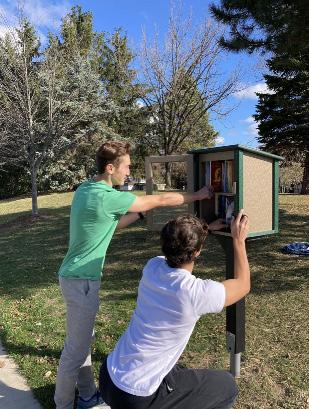
“I grabbed a bunch of middle school students that I knew were big readers and just asked in a couple of different advisories to see if students would want to come and help me load it up for the first time,” said Halliday. Anna Tukin ‘29 helped Halli-
day to initially stock the mini library. “Students can take a book and leave a book,” said Tukin. “I was excited to help with the mini library because I like making change in society, especially in the Greenhills community.” The mini library works through the exchange of books when people take a book and share a book. “The idea is that anyone who passes by can come and take one and hopefully, anybody who passes by will also at some point leave one,” said Halliday.
“There is just this constant exchange of free books going back and forth.”
One of the benefits of the mini library is that it is an equitable, accessible source of books for Greenhills and the broader community. There is no charge or membership necessary to use the mini library.
“I’m really hoping that everyone in our community – both inside our Greenhills school community and in our neighborhood outside – will just feel the joy of sharing books back and forth and feel like they are accessible and that they can get them at any time,” said Halliday. Halliday said that the reaction from students and adults to the new mini library has been overwhelmingly positive. One challenge in making the library fully operational is ensuring more students and community members know that the library is available for their use.
“It was a little slow at first, but now I am noticing that there are a few more books gone. I am hoping that it will get more and more use both from our students and parents and even staff,” said Halliday. “[I am] also hoping that the community around us -- people that walk by, that walk their dogs in the area – will stop by and take advantage of it.”
Given its location near the main school entrance, the new mini library’s appearance is still reaching upper school students.
“I did not know about the mini library before but I would love to use it now that I know,” said Renia Khan ’25. “It will be really fun to find new books from there”.
“The event gave me insights on how broadcasting is done at a professional level,” said head of statistics, Abraham Fayad ‘23. “I can use this to incorporate better practices into my own work and the Greenhills broadcasting team. As the head of stats, my team records all the individual player performances and analyzes it for the commentators’ use. In order so that the audience has a better picture of how the game is going.”

Thursday, December 8, 2022 The Student Newspaper of Greenhills School Volume 23, Issue 2 GRABBING A BOOK Lincoln Cha ‘24 (left) and Nate Gajar ‘24 make use of the new mini library. “I am glad that we have a small library because I liked reading in middle school and now they have a space where they share books and give books,’’ said Gajar.
POSITIVE PREPPERATIONS Architectural renderings of murals that will line the athleric entrance hallway. The west wall focusing on sleek branding of the athletics program while the east wall focuses on showcasing photos of recent Greenhills athletes at their own individual activities
FROM THE FIELD
a
expierence,
in the booth to taking photos on the field, I was able to encounter all the aspects of a highly competitive game from one of the best stadums in Michigan,”
“It was
surreal
from broadcasting
said Sarah Horan ‘23
FROM RENDERINGS TO REAL LIFE Progress took place in early December, with the wests’ walls lettering getting attached just in time for the upcoming Basketball season.
Photo courtesy of Hannah Lee ‘25
Photo courtesy of Michael Shaw
Graphic courtesy of Michael Shaw
Photo by Zara Mian ‘25

Forget the blue check
Senior sees red flags in Twitter ownership

If you were to take out a depos it of $1 billion in one dollar bills and stack the bills on top of each other, you would get a tower that is over 330,000 feet tall. This tower would actually leave the atmosphere and go into space. Now, multiply this by 44: that is 14,520,00 feet. That is the amount of money Elon Musk has spent to acquire Twit ter.
Before he bought Twitter, Musk talked about how he would bring back free speech. How we would let everyone back onto the app, especially how he would let former President Donald Trump back. He made claims that he was buying the company to protect free speech, however, these claims are false, he bought this company for one reason and one reason only, to make money.
Musk made two big moves as soon as he acquired the company. First, he let off 3,700 employees, or almost half of the company’s workforce, and then he introduced a new subscription, Twitter Blue. Twitter Blue is the end of credibility. For $7.99, anyone can go onto the app and verify themselves. For just eight dollars a month anyone can go on the app and get the once-coveted blue checkmark. Even a third grader could predict that this isn’t the greatest idea. As soon as the service launched millions of users decided to make fake accounts, verify themselves, and spread false information. Tweets about banana companies taking over the government, Lebron James leaving the Lakers, big pharma companies making insulin free, and countless others have populated Twitter over the past few days. Eli Lilly, a pharmaceutical company, dropped $15 billion because of a fake Tweet from a verified account.
money off of ads, and if companies don’t want to pay as much for ads, the social media companies lose billions in revenue. Companies like Meta, Google, and Amazon have lost billions, and in some cases trillions, of dollars. To cope with the losses, companies may follow Musk’s

ter to exploit.
It doesn’t matter what Musk does to Twitter, we will survive without it and move on to the next way of communicating, we might even forget that it ever existed at all. But what then? The next startup will be bought by the next gazillionaire, the same terrorists will say the same hateful things, and the snake winds tighter, demanding more attention, more outrage, more eyeballs

having our free media then we should care about what is happening at Twitter. If the company is able to use the subscription method successfully, other companies will adopt the subscription method. I can’t think of any other way the companies will go. Companies are no longer willing to spend as much money on advertising on these platforms. With this money gone, media companies need to find a new revenue stream, and this revenue stream will come from subscriptions. There may be a future where we will all have to pick some of our favorite social media apps and only use those, just like how we have to choose streaming services.
Twitter Blue was a terrible idea from the start, but maybe it needed to happen. Twitter currently loses over $200 million a year. With the verification system analysts expect Twitter to make around $72 million a year, this would take a big chunk out of Twitter’s debt. With a recession looming, consumers are spending less, and this is causing advertisers to want to spend less on putting out ads. Social media companies make all of their

“Fail Fast,” “FAIL: First Attempt in Learning,” “Don’t be afraid to fail.” Every other classroom has a poster something along those lines. As if exposure alone would make us believe in their message. Our “mindfulness” oriented classes preach the philosophy of growth mindset. It’s the idea that failure leads to learning which leads to better outcomes, that failure isn’t something to be afraid of or devastated by, but to embrace because it helps us to succeed in the long run. Growth mindset goes along with a whole slew of other pseudo-science self improvement psychology including “fail fast,” an idea infamous for enabling money-burning in Silicon Valley.
We have nothing against growth mindset on a psychological level. People who believe that they can get better handle failure better. But it isn’t something you can, or should, try to teach.
At Greenhills, our classes aren’t competitive, they aren’t curved, one might even say our grades aren’t harsh enough. Because many of our class grades are cushioned by “completion grades”
Cash is king, there is no way around it. Musk is not here to protect your free speech. He is here to make more money. Social media companies aren’t here to help you connect with friends or relatives. They are here to make money off of you. The moment they stop making money is the moment they will change things. It paints a bleak picture for the future. Free freedom of speech is becoming a thing of the past, in the future you will be free to talk, but you’ll just have to pay a small fee.

to outweigh tests, quizzes, labs, and papers , failure to learn is hard to see. Growth mindset helps us to bounce back from failure, but we’re not convinced that we know what to bounce back from and when to be concerned. If we get 85 percent on a test and the rest of the class get 90s, then have we “failed”? You wouldn’t think so just by looking at the grade at face value. But if that test was supposed to be free points then yes, that is something to be concerned about.
We are grateful that our classes don’t force us to compete against our peers. We are grateful that we have teachers that will talk about how we’re progressing, or if we’re not. We are grateful that we have classes where the emphasis is on learning rather than on a grade. But grades exist for a reason. They exist as a proxy for your understanding of the course. Take a standard class that has homework, classwork, tests. Which one of these is representative of your understanding of the material. Just tests? No. There’s more to taking those than just your knowledge. Classwork? That can’t
our free speech?
Many astute writers have no ticed how unprecedented it is for the world’s richest, most powerful, least charismatic man to own what they like to call the “virtual town square.” And it’s true, there is a tremendous possibil ity that Musk will run Twitter, a com pany that loses $221 million every year and is proud that they are doing so much better than in prior years, into the ground. Maybe he will create a safe haven for hate speech and trolls, maybe he will open the floodgates for misinformation and prejudice, or maybe he will turn it into a peaceful utopia for respectful discourse. I still won’t care. Why? Not just because I don’t use Twitter or Facebook or any of the countless other social media, but because no matter what happens we have already lost. We live in a world in which our rights are based on the whims of billionaires, where our words are not controlled, but moni tored closely and packaged for sale, where our human interactions are sim ply a resource for companies like Twit
be right, your teacher and peers are there to help you then. Homework? Ha! The teacher probably doesn’t even grade it. All of them combined? That’s too muddled and cushioned to matter.
The goal of school is to learn, not get a good grade. But in our climate, grades seem to be the main motivator for students. So, we don’t ask for cushioned grades or competitive ones, but honesty. Grades that lay bare our weaknesses and strengths.
Another consequence of unrepresentative grades is a tendency to be blindsided by failure. When we think that everything is fine, grades are high, tests are fine, studying is challenging but manageable, and then failure hits, it hits harder and is more difficult to recover from than if we were prepared. Maybe you knew all the material in the unit, so it wasn’t that you didn’t study hard enough. It was multiple choice, so it wasn’t that you tripped over your words. Your friends did fine, so you’re at the bottom of the class. And you tried, and it ended in failure, so you think that hard work doesn’t correlate with success.
But don’t worry, they say!
Didn’t we learn what to do in this exact scenario in FRESH? Just remember those brightly colored posters and Ted Talks and everything will be all right. We are, of course, joking. FRESH and SHUSH and all the other times we hear about growth mindset are good introductions to the concept of growth
And all that because we put our faith, our rights, into a silly dream that companies would never choose money
So, who cares about Twitter or Musk? They’re just a bunch of “rational” people following the incentives that we’ve laid out for them. As consumers w e have a choice, to keep hoping that things will get better, or to stop fallwheel, to choose to words again. not as if the latis impossible. In my experience, people hate the media; they come for the social. We can take back the power from companies to control our speech. I’m not proposing that we start scratching messages into rocks, or god forbid talk to each other face to face, but we definitely


DEC. 8, 2022 Growth mindset isn’t a fix-all Alcove is a newspaper written by students, for the students of Greenhills School. All opinions, views, and statements reflect those of the students working on Alcove and not necessarily the faculty and staff of Greenhills. Alcove is written to inform, encourage, and expand upon the curiosity of the students that Greenhills strives to cultivate. Providing a forum for students to express their individuality, the Alcove reminds you to always read the pine print.
mindset, but that’s all they are, an introduction. Because this crucial skill isn’t taught, it’s developed through living life. Saying buzzwords like “growth mindset” is fine, but the concepts they represent won’t become concrete until you encounter them in the wild. Like any other skill you can’t teach how to learn through brute force, you just have to practice and give it time. There’s good news too though. We have teachers, advisors, and family to help when things feel like they are falling apart. The important parts of the process are there, so all the school needs to do is have faith. To trust us to handle tough material, trust teachers to give fair and honest grades and coursework, and trust us to grow, and practice, and learn. Editor-in-Chief Musatafa Zirapury ‘23 Associate Editor, Print Nate Burke ‘23 Associate Editor, Online Arjun Prabhakar ‘23 Associate Editor, Design Devyn McGow ‘23 Managing Editor Fiona Lin ‘23 School Editor Sarah Horan ‘23 School Staff Rishi Verma ‘23 School Staff Chakor Rajendra ‘23 School Staff Zara Mian ‘25 Opinion Editor Anjan Singer ‘24 Lifestyles Editor Eva Bernstein ‘25 Lifestyles Staff Ahmad Hasan ‘23 Lifestyles Staff Dhruv Nallamothu ‘25 Lifestyles Staff Megan Peng ‘25 Sports Editor Leo Applegate ‘23 Sports Staff Nick Alumkal ‘23 Sports Staff Jack Hauptman ‘23 Sports Staff Matthew Streicher ‘24 Photographer Annie Stone ‘23 Advisor John Lund Button your beak Enough with the Twitter talk MUSTAFA ZIRAPURY ‘23
Graphic by Megan Peng ‘25
PAGE 2
Graphic by Megan Peng ‘25

School doubles student counseling resources
School Staff
RISHI VERMA ‘23 School Staff
Common belief is that Greenhills is a private school but, the proper classification for this institution would be as independent. The difference between a private and independent school is that a private school is not bound to be held accountable whereas independent schools must receive some type of accreditation. As an independent school, Greenhills goes through a process to prove that the school is implementing its mission in all aspects: academics, sports, art, student life, facilities, and more.
“We get accredited through the Independent Schools Association of the Central States organization,” said Bridget Maldonado, middle school dean of students and ISACS committee chair. “This accreditation is important because it shows that we at Greenhills care about constantly improving and doing the best we can,” said Maldonado.
The accreditation is not the only important thing to help the school grow.
“Any school that wants to be known as an independent school must go through the ISACS accreditation process,” said Maldanado. “Getting accredited through the ISACS board also shows colleges that all our applicants come from a good place, and helps to show the standard they were held to as students at Greenhills,” said Maldonado.
ISACS accreditation is a constant seven-year cycle. According to ISACS, the cycle is as follows: the first year consists of preparation, where any institution seeking accreditation will put together their committee chairs, conduct school community surveys, plan for the following years, as well as go through the schools bylaws to make sure they reflect what ISACS believes in. Year two consists of the self-study process, where the school will conduct various student, faculty, and even alumni surveys and put together the various reports for the different departments and opportunities the school has to offer.
“We are currently in year two of the accreditation cycle,” said Maldonado.
Year three consists of accreditation. The school will submit their self studies and then welcome the ISACS accreditation team into the community for a three-day visit (72 hours). In this time, the ISACS team will be visiting classes, talking to faculty, administration, and students; with the main goalto verify the self evaluations submitted and if the school is actually implementing what it says it is.
“The ISACS team will be hard at work writing and reviewing feedback for our school and at the end of the 72 hours when they leave, we will be given a review report, with their feedback,” said Maldonado
After year three is when the school will be given its accreditation.
“The school’s reaccredited after year three because at this point it will have shown that it can honestly reflect upon itself and is committed to growth and improvement,” said Maldonado. “Oftentimes the feedback we receive shouldn’t come as a surprise as usually what the ISACS team suggests is what we already planned on implementing in our self study,” Maldonado said.
Year four consists of the reaction report, which entails how the school responded to the ISACS team’s feedback, and how they plan to implement any suggestions. Year five consists of implementation, time for the school to put into action what they once lacked from the reaction report. Year six is when the school will write their progress report on ways they’ve implemented the suggestions and grow as an institution. Year seven is when ISACS will review the school improvement in the seven-year cycle. The year after, the cycle immediately starts again – promoting constant growth and improvement of an educational institution.
It isn’t just certain people who have a say in the ISACS report. The whole school community is involved. “The survey we sent out to all students is so that they get a say on where the school goes,” said Maldonado.
There are also two aspects to the reflection.
“I’m more in charge of the student aspects, whereas Mr. Fayroian is more generally involved with both the school governance, and financial aspects of the school,” said Maldonado The head of school serves as a coordinator for the whole process.
“I’ll work closely with the visiting team leader as well as with the board and generally oversee the whole process,” said head of school Peter Fayroian.
Students can see the value of the accreditation process as well.
“It’s great to see that we get a say through surveys, and that the school seeks this accreditation because not only does it make the school a better place, but it also does the students justice in the sense that when we apply to colleges, they’ll know exactly how great the education and community at Greenhills is,” said Meezan Hamzavi ‘23.
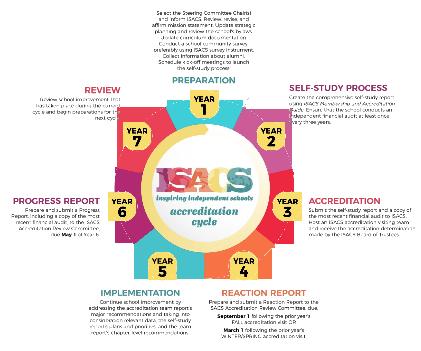
Faced with an increased demand for student mental health resources, Greenhills hired a new school counselor, KJ Johnson, doubling the number of school counselors on its staff.
Director of school counseling
Heidi Butz cited several reasons why it was important to hire an additional school counselor. Butz noted that the school has seen rapid growth in recent years. She pointed out that there were 530 students at Greenhills when she began her position in the fall of 2016. With approximately 700 students in the school today, Butz said that one school counselor was not enough to meet the mental health counseling needs of the students.
“For the first time, Greenhills now has two school counselors, which is an awesome thing,” said Johnson. “So with that, the number of resources has doubled.”
Not only is the rising number of students contributing to the greater need for school counselors, but also the greater openness to seeking mental health support among students.
educational and community resources. “We [the school counselors] are here to provide counsel when students are having a hard time. And when I say the hard time I’m not just meaning at school, but also in life,” Johnson said. “We both have access to outside resources that we share with students and families when we feel as though more help or expertise is needed.”
three months at the school, Johnson highlighted a need to help students realize that they do not need to be in a “full-blown crisis” to come to see the school counselors. Test stress, pre-game nerves/fear, working through an argument with a friend/ classmate. These are just a few of the things we can and do talk with students about,” Johnson said.
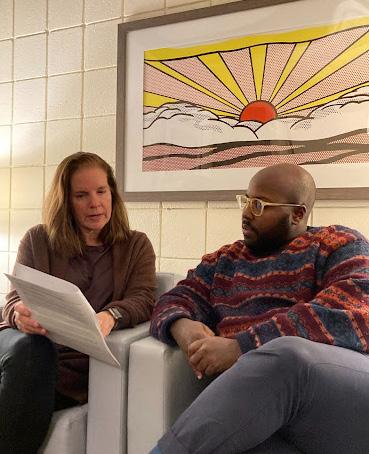
“The positive thing is that in our society, the stigma around mental health is decreasing,” Butz said. “Students are more confident seeking out mental health support than in the past.”
She also stated that due to increased stress during and the challenges of the COVID-19 pandemic, more students are reaching out for mental health resources. “We both are here to support students during the school day in their social and emotional well-being,” Butz said.
Other resources that are available to students and community members include the peer-to-peer mental health awareness and outreach club in the upper school, which is sponsored by the school counselors. Butz and Johnson also have
RISHI VERMA ‘23
School Staff
Over the summer, the service department worked on finding a solution to making service at Greenhills what the institution has always wanted it to be – more meaningful and personal to the students and communities it serves. In previous years, there were various service oriented clubs and events. For example, on Motor City Saturdays,students go to Detroit for additional service. Now, all service at Greenhills is included in the SLICE (Student Leaders in Civic Engagement) rogram.
“The SLICE program aims to make service more enjoyable and personalized to the students by allowing them to pick categories of service they feel they want to make a difference in,” said Equity and Education SLICE lead Meezan Hamzavi ‘23. “Once they’ve been assigned a category, they would be providing service in those categories on the two school service days and offered opportunities in those categories.”
SLICE offers students to be grouped into one of five pathways for service opportunities for the year. The five categories are Community Empowerment, Housing Crisis, Environmental Justice, Equity in Education, and Food Security.
In the upper school, each grade has had two service leaders.
“Though SLICE is a great addition to the community, the grade independent service leaders still have the role of tracking each individual student’s service hours to make sure they fulfill the graduation requirements,” said service leader Pranay Shah ‘23. “Our role is more on the student side of the service, and making sure everyone is on track.”
Students are sent a form at the beginning of the year asking them to rank which of the five pathways they would want to be placed in.
“Once a student is put in a given
Johnson described his role as school counselor as an ambassador for mental health, equity, acceptance of self and others, and community. He also noted that as a school counselor, he partners with different departments, teachers, and families. He described the sixth grade Successful Student Habits lesson focused on stress and stress management that he recently taught with learning specialist Allie Kaplan.
“That’s what school counseling has become. A beautiful partnership between all with the main goal being, equipping students with all that they need to live a fulfilling and healthy life. In whatever way that looks for them,” Johnson said. From what he has seen in his first
pathway, the leads for that pathway will organize where those students will go on the two schoolwide service days as well as find communities that they can build lasting relationships with through service,” said SLICE and Housing Crisis lead Fatima Shah ‘23. “For our last service day this fall, the people in my pathway (Housing Crisis) went to House N2 Home.” House N2 Home is an organization that aims to take empty houses and fill them with furniture and necessities for

Johnson said that he has not experienced students coming to him to talk as much and he has sought out students to talk.
“[W]e need to continue efforts to dismantle what perfectionism is. I saw this quote, I don’t know who the author is but it said, ‘Perfectionism is a delusion that can rob one of a very successful, enriching life if not careful,’” Johnson said.
Johnson noted that his journey to becoming a school counselor was not traditional. Initially, he considered becoming a physical therapist and studied exercise science. After graduation, he made the hard realization that physical therapy was not for him and started working as a paraeducator.
“It wasn’t until after I volunteered at my old high school to run the LGBTQ+ support group that I realized I wanted to be a counselor,” Johnson said. Ultimately, he pursued a second degree with a major in psychology and then, went to graduate school to receive a masters in counselor education.
Anjana Kanakamedala ‘24, who has advocated for mental health resources, said that the Greenhills community was very supportive of her while facing mental health challenges until it interfered with academics. She noted the greater need for balance between academic and wellness.
“I would like to see more communication between counseling, the learning center and students as well as more vessels of people who can help,” Kanakamedala said.
In describing her own experience with mental health challenges, Kanakamedala said that as much as teachers tried to help, “the reality is that the Greenhills community can be very harsh for someone who does not fit the definition of normal.”
into comfortable living spaces for the less fortunate.It felt good to give back.”
Before the SLICE program, service at Greenhills consisted of two service days: one in the fall and one in the spring. each service day, students would be given various options for things to do, and there was no connection between what type of service students were doing. SLICE aims to allow students to continue to work with the same communities or type of pathway on every service day/service opportunity so students can feel they’re making a lasting difference.
“Feedback from students over the years showed that our community loves to do service but wanted more opportunity to really connect with the communities they worked with,” said service learning department chair Alyssa Friendly. “This led us to introduce SLICE, where we choose five main categories to really focus on and just a few organizations under each category to allow for those connections and bonds to grow between our students and the communities we seek to serve.”
Under the SLICE program, students can access a Google Drive from Gryphon(student portal) where they can sign up for additional service opportunities within the pathway they chose or in a different pathway.
“I’m happy that I got to do service at a community I can come back to even without Greenhills involvement and that I may get to come back and work with the same people on future service days,” said Ben Formicola ‘24.
The SLICE program, though new, is already changing the way students look at service at Greenhills.
those who are homeless to then move into. “We helped clean up the courtyard by raking leaves, built furniture, cleaned trash cans, and organized blankets and dishes,” said Ally Tan ‘24. “Our work went to House N2 Home turning empty apartments
“I’ve always felt like we’ve gone and done service for a couple hours and then that’s it,” said Rayhaan Bhalwani‘24.
“With SLICE, it feels like service might actually become more impactful and genuine.”
DEC. 8, 2022 PAGE 3
ZARA MIAN ‘25
Students leaders help peers provide service opportunities TAKING OUT THE TRASH “I’ve never actually cleaned trash cans before but the House N2 Home leaders were super nice and I think it was great that they were also doing all the same service we were,” said Ben Formicola ‘24 who participated in cleaning up the HouseN2Home headquarters in Ypsilanti.
Photo by Zara Mian ‘25
Photo by Rishi Verma ‘23
THE PEACEFUL PAIR Heidi Butz and KJ Johnson talk over ways to help students in the upcoming semester. “I want to be the counselor I needed ” said Johnson.
Graphic by Mustafa Zirapury ‘23
ISACS accreditation: School begins self study


Students by day, baristas by night
Greenhills’ Starbucks employees recommend winter drinks




Peppermint mocha creams the competition

Sliding into winter
Huron Hills is students’ favorite sledding spot by an avalanche
[Huron Hills] for a lot of reasons,” said Ismael Metwally ‘23. “It’s super close to my house, so I don’t have to worry about driving with all of my coats and stuff to go sledding. It’s also really big, so even if there are a lot of people, I don’t have to worry about it being crowded or anything.”
Huron Hills has not been without fault, however, as Metwally recalls many incidents at this spot.
steep enough that you can really go fast,” said Bechar. “There have been some times where I’ve found myself flying off of my sled.”
On the west side of Ann Arbor is Veteran’s Memorial Park, a popular spot that also holds the thrills that steep hills provide.
Winter wonder world
Student, faculty cultures shape holiday traditions
DHRUV NALLAMOTHU ‘25
Lifestyles Staff With the holidays approaching, many Americans are getting ready to decorate Christmas trees, light menorahs, and build gingerbread houses. However, there are billions of people around the world who celebrate in different ways.
Maraki Tamrat ‘23 lived in Vienna, Austria, for the first 15 years of her life. Among the many memories she made in Austria, holidays have always been special to her. She says Catholicism played a huge role in Vienna’s Christmas celebrations.
“We followed Christian holidays and traditions,” Tamrat said. “We had one tradition where children would leave their shoes by the doorstep so when St. Nicholas (Santa Claus) came he would put presents in them if they were good, but if they were bad, he would put lumps of coal in them.”
However, there were some differences Tamrat described that put a darker twist on these stories. Many children would listen to their parents throughout the year so they wouldn’t be noticed by Krampus, a demon from Hell. “He would come and put children in their sacks and then burn them,” said Tamrat, “This was something that scared a lot of children in Austria.”
The whole city is very festive around the holidays. Many people join together in the festivities and celebrate together. In the center of Vienna, there is always a Christmas market.
dition to go to a Christmas market. They also sold Advents calendars, which are the calendars with little chocolates in each door that represent a day. I still get them every year.”


Out of a poll of 50 students, Huron Hills was the most popular location for sledding. Veteran’s Memorial Park was the second most preferred, with Barton Hills as the third. An “other” option tied with students’ own house or yard for fourth, and Burns Park was the fifth most chosen.
The first, most popular location lies just zsix minutes away from Greenhills. Although being one of Ann Arbor’s most popular golf courses in the summer, Huron Hills attracts people of all ages once the snow begins to fall.
Under the right conditions, its lengthy, sloping hills provide the perfect oppor
“One time when I was a kid, I was sledding with my older brother, Yaseen, and some kid stole my sled,” said Metwally. “I tried to chase after him but he was too fast; I ended up slipping on ice and tumbling down the hill. That wasn’t a very fun experience but it’s been nice outside of that.”
Although Huron Hills is popular, some students prefer a smaller, more enclosed environment like Barton Hills.
“Barton Hills has to be my personal favorite, even though I don’t go very often,” said Yoel Bechar ‘24. “It’s a pretty far walk from where you have to park to get there, so there usually aren’t very many people. I also went
Veteran’s Memorial Park, more commonly known as just “Vets,” serves many other purposes besides sledding. In the summer, Vets supplies both a pool with a water slide and multiple baseball diamonds where various Little League teams play.
In the winter, however, the park officially closes the pool and diamonds and opens its ice rink. With this change comes the unofficial opening of the area behind it – a massive hill that serves the sole purpose of sledding. 20 percent of students polled enjoy visiting Vets Park the most, the second highest out of the results, 8 percent more than Barton Hills’ 12 percent, but 10 percent less than Huron Hills’ 30 percent.
Students like going to local

Spanish teacher Jenniffer Gray lived in Spain for five years and still goes back for the winter holidays every other year. Spain has a large Catholic population. With an abundance of festivities during the winter, their Christmas season lasts longer than in the U.S. “There are more days where they really celebrate in pretty big ways,” Gray said. “The big day when people give presents is called the Epiphany of Spain, or Los Reyon Majos, it’s on Jan. 6. It’s the day when the Three Kings bring gifts, which is based on the Catholic holidays, these were the kings that brought gifts to baby Jesus.”
family, friends, and feasting. Above all, New Year’s Eve is Gray’s favorite holiday in Spain. “It is a day to be with family,” Gray said. “We have this huge dinner starting at 9 p.m. and we have seven courses of seafood and finish around 11:40 p.m. Then we get a plate full of 12 grapes and during the chiming of the city bells, we have to eat all 12 grapes in order to have good luck for the upcoming year.” Gray likes to keep this tradition alive with her family and friends. On New Years, she gathers with family and friends on Zoom to share the experience annually.
ed with the grapes at midnight.” Gray said. “We stream the clocks from Spain and our friends and family will tune in from wherever they are and eat the grapes with us.”
After a heartfelt celebration with family where everyone has champagne and dances together, young people go out and party with their friends. At 2 a.m. the streets will be lively and filled with people. This goes on till 7 or 8 a.m. when people finally return to their homes and go to bed.

“My family and I would always go to the Christmas market where people would sell Gingerbread and toys and presents.” said Tamrat, “In Austria it is a huge tra-
In Spain, people still celebrate Christmas and Christmas Eve with the Three Kings, who are similar to our Santa Claus. They rejoice with days filled with
“Before the pandemic, we had discovered zoom and we had friends in many places and every year for New Years. For the past 10 years we celebrat-
‘Home Alone’ on a ‘White Christmas’: festive films teachers, students ‘Love Actually’
MEGAN PENG ‘25
Lifestyles Staff
As we near the end of the year, everything begins to take on the themes of the holidays—decorations, carols, and the cold weather all hint that Christmas is arriving soon. Students and teachers enjoy the holidays and cold weather with their favorite holiday movies and films.
“Home Alone” is considered a classic. Its comedic script and scenarios make it a popular selection. “I really enjoyed the first Home Alone movie,” said math teacher Ben Russel. “It was a fun movie to watch as a kid, and I liked the thrill of being home by yourself and having some slaps of humor and nonsense traps.”
For a majority of people, watching old Christmas movies and films brings the feeling of nostalgia.
“Home Alone holds a very nostalgic place in my heart, and it has a lot of entertaining and funny moments, ‘’ said Jacob Perkins ‘25. “Some of it was also set where I used to live. I used to go to my Boy Scouts meeting in the same church that was in the movie, which was also pretty cool.”
Some students have a more varied taste. Although Violet Weizer ‘25 is Jewish, she still enjoys watching many Christmas movies that she finds entertaining.
“One of my favorites is the original Home Alone, and I really enjoy Elf, and watching The Nutcracker ballet dance, so I also have a DVD of that,” said Weizer.
though it has, in the United States, really boosted capitalism,” said Berhringer. “Here, Christmas is more about buy- ing gifts instead of celebrating tradi - tion. Although people proba - bly watch Christmas movies for nostalgia, it’s not really a thing I do or plan to do in the future.”
“You only get to sleep for a few hours because then you get back up again and have another big family meal,” Gray said. “One thing that is really special to me is the balance of family and friends and the celebration. It’s a much longer holiday and way more festive, but I will always love holidays at my parents house here, the most.”
In the southern hemisphere, Christmas looks a lot different. Graeme Jagger ‘23 lived in Malawi and Uganda for one year each. The holiday season is very different due to the flipped seasons.
“Having Christmas in a place where it’s the warm season is very strange,” Jagger said. “Usually around Christmas time, you’re bundled up by the fire, but living in Africa there are more outdoor activities.”
While Americans are stuck inside watching holiday movies, Africans are having potlucks and picnics. Jagger loves to spend time outside during this time and appreciates the endless possibilities of activities in the warm season.
Although the winter holidays look very different around the world, they all have one thing in common, spending time with family and friends.



and singing the song in my high school musical. The dance numbers are also out-of-this-world good.”
For Noelle Pacifici ‘24, the memories formed from watching these movies with loved ones can persist after they have passed.
“My favorite Christmas movie is National Lampoon’s Christmas Vacation,” said Pacifici. “I grew up watching it on television with my family. I always used to watch it with my grandparents, so now that they’re gone, I feel like it has a lot more meaning.”
Having the yearly tradition of watching holiday movies with family and friends creates common memories.
‘25 LEO APPLEGATE ‘23 Sports Editor As the saying goes, in Michigan, only two seasons are certain: construction and winter. With winter comes a fresh unofficial sport – sledding. Fortunately, Ann Arbor’s hilly landscape provides the creation of sledding spots. What was once only a hill or valley in the spring or summer months may be transformed into a place in the winter where people of all ages can enjoy the snowy descent provided.
“Even though I’m a Jew, I really like Christmas movies, and they’re well done and there aren’t really any movies about Hanukkah that are interesting to watch for me. My favorite season is winter, so I like movies that are set in a winter-wonderland-like place.”

On the other hand, Hannah Berhringer ‘25, who is also Jewish, doesn’t have any interest in watching Christmas movies because they are not culturally relevant to her. ”At least for me, watching Chritsmas movies isn’t as relevant because I don’t celebrate Christmas even
Some movies such as White Christmas have been adapt- ed into musicals. “White Christmas has a lot of sentimental value,” said drama teacher Katie McBride. “I watched the movie with my mom growing up, and I loved the old fashioned feeling
“My favorite Christmas movie is Daddy’s Home 2. It’s a Christmas movie, but no one really thinks of it as a Christmas movie until you watch it,” said Sahana Patel ‘24. “Every Christmas time I watch it with my cousins, and we crack up every time we watch it. “ Some holiday movies also show representation of the LGBTQ+ community.
“My favorite is called Home for the Holidays,” said English teacher Kelly Williams. “I watched it for the first time in 1995, and then I tried to watch it almost every year. It was one of the only movies that showed a gay character, and showed him positively as a person who was welcomed by his family. I was in college at that time, and that idea was really uncommon in that era.” English teacher Mark Randolph has a more philosophical interpretation of his favorite holiday movies.
“I do watch Love Actually every year,” said Randolph. “The idea that love actually is all around us–gets me right in the old ticker. Emma Thompson’s performance is heartbreaking, and she’s just brilliant, and Hugh Grant is hilarious. But I have to admit also, there’s a rascally part of me that likes Four Christmases with Vince Vaugn and Reese Witherspoon. I think it’s absolutely hilarious.”






Graphic by Megan
Even as a child, Randolph deeply analyzed his favorite Christmas movies. “When I was a kid, liked Rudolph the Red Nosed Reindeer,” said Randolph. “I always wondered—I mean, there are a lot of really mean reindeer, and I’m not quite sure if


liked
as a
Santa doesn’t bear some of the responsibility for the values of his reindeer. Plus, I’m not sure that the Abominable Snowman was created particularly fairly, but I still
it
kid.”
Peng
Graphics by Megan Peng ‘25
me of times when I baked with my mom when I was younger and is a refreshing end to a day working at Starbucks.”
Anna Phillips ‘23 “My favorite winter drink is the Sugar Cookie Almond Milk Latte. It reminds
really like the Irish Cream
Brew. It’s a simple drink to make after a long work day at Starbucks and reminds me of my Irish roots.”
Makayla Jones ‘23 “I
Cold
for 5 months, I realized I really like the Peppermint Hot Chocolate a lot more than I should. It’s like the Peppermint Mocha
Santa, baby! Match the teacher with the man in red A. B. D. C. E. F. G. H. I. J. Answers: A. Caitlyn O’Neil B. John Lund C. Mackenzie Hess D. Laurin Wolf E. Alyssa Friendly F. Eric Gajar G. Caroline Huntoon ‘02 and Gregory Huntoon ‘07 H. Lisa Beatson (on the left) I. Bridget Maldonado J. Lisa Flohr
Devyn
McGow ‘23 “After working at a Starbucks in Northville
but without the caffeine, making it the perfect drink for Compiled by Ahmad Hasan ‘23, graphic courtesy of Griffin White ‘23
Poll conducted by Sarah Horan ‘23 and Eva Bernstein ‘25, graphic by Megan Peng ‘25
Graphic by Megan Peng ‘25
Graphic by Megan Peng ‘25 Photos compiled by Eva Bernstein ‘25 and Dhruv Nallamothu ‘25 NOT A GREEN STRAW IN SIGHT Alcove staffers ranked Starbucks winter beverages Nov. 16. Better luck next time, Caramel Brûlée.
24 percent 22 percent 19 percent 19 percent 16 percent

Holy Toledo! Five Ohio schools added to Catholic League
JACK HAUPTMAN ‘23
Sports Staff
The Toledo War in 1835 was an almost non-violent dispute over the territory of Toledo between Michigan and Ohio. From which Michigan gained its statehood and the Upper Peninsula in exchange for Toledo. Today, some schools in Michigan and Ohio still battle over sports. This year, the Detroit Catholic League is adding five new schools from Toledo, Ohio, of all places: St. Francis de Sales, St. John Jesuit, Toledo Catholic Central, St. Ursula and Notre Dame Academy.
“It’s hard to move individual teams every year; it’s better to make bigger planned changes than just moving one team every year,” said athletic director Meg Seng.
Sports leagues are designed so that teams from different schools can have an easier time finding other schools to play against. They serve as a network of opportunities for schools to take in order to mutually benefit by having their athletes practice and refine their skills against each other in a competitive manner.
“Those schools that have trouble scheduling competitive games for smaller sports will have more options for schools to schedule against.” said Seng. “The League has never been bigger than 30 some schools. We play in different divisions within the league. In tennis we play in the upper divisions. We’re able to move up and down within the league for better, more fair games.”
Greenhills first joined a league in 2009; however, it later switched to the Catholic League in 2016. As the Catholic league itself has been limited to only Michigan Schools, a new batch of incoming schools may give athletes a change of pace.
“The changes are healthy for the league by making our divisions more competitive and more balanced. You want to create divisions that work and get rid of uneven numbers in divisions while keeping up competition,” said Seng. “We used to have to search for everybody before being in a league. After joining leagues it is easier to find games.”
Right now, the school mainly plays in Michigan and prioritizes closer schools for scrimmages.
When asked about whether athletes will have to travel to Toledo, Seng said “Yes, they will. To be fair, we already travel to Ottawa Hills and Maumee Valley in Toledo for both middle school and high
Because Toledo is in a different state, it may seem like it will take longer for the buses to get there, adding more travel time onto student athlete’s already busy lives. Some students have expressed their disapproval.
“Why do we have to drive even more now?” said student athlete Aidan Woerpel ‘23. “It’s annoying because we never have games that are close to the school and now we have to have even more that are far away.”
The changes affect viewers as well. “I love watch-

school contests. We have competed with them for as long as I’ve been here, which is over 30 years.”
Equestrians trot through highs, lows
MATTHEW STREICHER ‘24
Sports Staff
Equestrian was once a sport offered by the athletic department. Though today, it no longer exists for the Gryphons, the community is still full of riders that dedicate their life to building lifelong connections with horses.
Charlotte Jordan ‘24 has been riding since her early childhood.
“I started in first grade because my friend was doing it, and she asked me to do it with her,” said Jordan.
Ella Kim ‘24 got into the sport due to their love of animals.
“I’ve always loved animals, especially horses, so when my mom found a horse riding camp nearby, she signed me up and from there I fell in love with it.”
Both students practice and do shows outside of school, but it is a very different situation for Jordan who recently returned to the country from Europe after four years living there.
since her early childhood. Walsh placed top in her division last season. She competed in events like hunters and jumpers.
“What makes horse riding special to me is having a partner,” said Walsh. “It’s not neces-
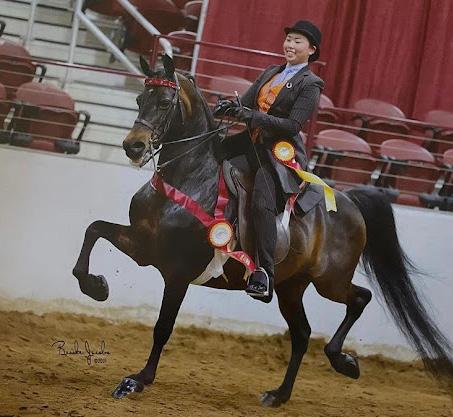
“I practice once a week, but I don’t have a place here yet since I just moved here, but before, it was just at a local stable,” said Jordan. “I didn’t do shows for a while because I was in the Netherlands, but usually, they don’t take much time away from school because they’re on weekends. Unless they’re big shows, but I haven’t done those yet.”
Kim has a different practice schedule. “I have two group practice rides, one private ride, and one conditioning practice weekly. So, just about four rides a week consistently. I’m also a working student and instructor so sometimes I’ll ride just for fun or to exercise the horse,” said Kim. “I just got back from my last A rated show for the season.”
Jordan does have some future plans and ambitions for riding after leaving high school. “I’d like to keep riding after I leave high school, for the rest of my life,” said Jordan. “Not as a career, but more of a hobby.”
Kim has similar aspirations about their future in the sport.
“I don’t think I could live without riding. I took a short break from it when I was younger, but there was no way that I could stay away from it.”
Riders not only share passion for just riding, they also love working with the horses.
“My favorite part of horse riding is hanging out with the horses,” said Sairose Walsh ‘25, who has been horseback riding
sarily a team, but you have to find a connection with the horse.”
Indeed, equestrian riding is more than just hopping up on the back of a horse and taking the reins, it is forming real connections with an animal for a lifetime.
“It’s not just a sport. It’s a lifestyle,” said Kim. “It’s mental and physical work, but you also have to take into account that your teammate is a 1000 pound animal and your only means of communication with them is essentially your body.”
This is what makes horse riding unique. It allows for a bond to form between the rider and the horse in which they rely on and trust one another.
“There’s really no other sport where you can do that,” said Kim. “It’s creating a silent bond and being able to communicate without words, which is really incredible to me.”
Horseback riding isn’t a trend – it has been around for thousands of years. Some faculty members also grew up as equestrians. Arts teacher Nicole Burroghs is a known rider.
“I have done horse-riding for roughly 25 years now,” said Burroughs. “Riding is something that forces you to go out of your own head-
Additionally, the Gryphon Sports Live team, who cover and broadcast these games are affected.
“The more teams in the league the better, this leads to better tournaments.” Said Head of Stats and commentator at Gryphon Sports Live club, Abraham Fayad ‘23. “Usually, I have to travel under an hour to get to games, but Toledo is farther than most schools.”
However, these circumstances might not always be the case.
“We have competed against other schools in Toledo before. We already compete in Marine city in Michigan. (Which is 80 minutes away compared to the 50 minutes that Toledo is),“ said Seng. “For us, getting to Toledo is easier compared to other schools. A trip a lot of our teams have taken before. We hope to schedule trips to Toledo on Fridays or Saturdays.”
While league games will become easier to schedule with more teams in the league, Catholic League championships become more complicated when adding schools from another state to the equation.
“Our state association, the MHSAA, is different from that of Ohio,” said Seng.
“Ohio schools cannot compete in Michigan state championships. Only Michigan schools can compete in Michigan championships. However, some sports are different, they [the Toledo schools] have gotten special permission to play one date in Michigan in the fall.”
Ohio schools play out of season in the spring for sports such as tennis, and their spring season scores are seeded into the Detroit Catholic League Tennis tournament tournament, which takes place in the fall.
“When the tournament is being seeded the Ohio spring scores are worked in,” said Meg. It is hard to seed a bunch of schools from other states,” said Seng. “We are just going to try it and see how it works for the league.”
ing sports, but I’m never going to be able to travel to Ohio for just a game to watch,” said Gryphon sports fan Paul Prokorov ‘23.
space, unlike other sports or athletics activities.”
Whenever Burroughs is riding, she is actively communicating with the horse, which hinders her from thinking about any other problems or situations. For Burroughs, being an equestrian is an escape from reality, as it forces her to live in the present.
“If I am running, I can still be thinking about things that are stressing me out,” said Burroughs. “On a horse, you cannot think about anything else.”
Horseback-riding – dressage, in particular – for Burroughs, presents opportunities and challenges that require time, commitment, and energy. As a bonus, Burroughs gets to bond with each horse that she rides.
“My first horse’s name was RZ,” said Burroughs. “His full name is Restless Zenith. Thoroughbreds like RZ have weird names on race tracks.”
Today, Burroughs owns Chip, and continues to spend time with him.
Another faculty member – social sci-
“I used to ride him six days a week. Even when I didn’t, I went out to the barn a lot to feed him, care for him, and make sure he was on his best behavior” said Vane. “It’s harder to do that with a family now.”
The hope is to be able to return to that at some point. For Vane, there is no connection other than being able to clear her mind after school with Louise in the countryside.
“You can’t take out your anger on horses, so you are forced to center yourself,” said Vane. “Overtime, you develop a cool, invisible language with them.”
Horse riding, above all, has pushed Vane to be attuned to the unpredictability of life.
“Your horse could be amazing and going strong one day, and the next, they’re threelegged at length,” said Vane. “You can have all the plans in the world – train them, condition them, prepare yourself for a show – and the day before a show, they break themselves. Horses are like bicycles that can injure themselves.”
Through all the smiles, falls, and inju-

ence teacher Kate Vane – has also been riding for more than 20 years.
“I have been riding since I was nine, but stopped in college and early in my career because horse riding is very expensive,” said Vane. “It takes a lot to be able to have a horse and ride it regularly.”
Vane has owned her last horse Louise for about ten years now. Up until last year, she frequently brought him to competitions and showed him around.
ries, riding a horse isn’t a commitment to perfection, but one to evolving. There are no instant results in horse riding. It’s all about patience and progress.
“Riders all share the same mentality: there are really high highs, and really low lows, and lots of hard work in between.”
PAGE 6 DEC. 8, 2022
Graphic courtesy of Griffin White ‘23
JUMPING INTO ACTION Saoirse Walsh ‘25 riding her current horse Carlos. She placed top in her division last year. “I am around the intermediate level and compete frequently,” said Walsh.
is just a nice way to have an escape
school
life.”
“It
from
and other aspects of my
TWO LIVES HARNESSED TOGETHER Ella Kim ‘24 riding with her first horse. “This was our first show together, and I could not wait for more.”
Photo courtesy of Ella Kim ‘24
Fiona Lin ‘23 and Arjun Prabhakar ‘23 contributed to this story
Photo courtesy of Saoirse Walsh ‘25

Athletic dept. tackles sports budget
NATHAN BURKE ‘23
Associate Editor, Print FIONA LIN ‘23
Managing Editor
Heaps of sports equipment and bags are found throughout the school, whether they are on the tops of lockers, half-stuffed into cubbies, or just strewn about on forum tables. Athletics are visually present in every nook and cranny, but there are hidden costs. Here, the athletic department does not track expenses per sport; rather, they look at the big picture.
In the last fiscal year, which began in July 2021 and ended in June 2022, the total expenditure of the athletics department amounted to $350,000.
“It is a lot of money, but only about 2.3 percent of the school’s total budget,” said athletic director Meg Seng. “We feel like the value added is tremendous. Think about all the things you get when you’re on a sports team.”
Of the total spending, more than half was dedicated to coach salaries. The department employs profes sion
an established sport at Greenhills.
“A boat is $20,000 to $30,000,” said Seng. “We already have a hard time expanding our rosters for some sports because the middle school is really full. We are creating more teams to satisfy the need; more teams means more coaches, more money.”
The school hires certified trainers and licensed nurses who work at MedSport, the official medicare care provider at the University of Michigan.
“In sports, there is high exposure to injuries,” said Seng, “the school nurse was SteveO, but the liability is too great to put on just one person.”
The school has since hired registered nurse Chris Gajar, who oversees all medical issues including concussions and COVID-19 cases.
In 2020, the school announced plans to build a brand new turf field with a full-sized olympic track. Following two years of construction, the field was complete. While the transition to turf has had many benefits, there have been

expenditures, the other half of the total budget was allocated to a variety of other categories. Sports that cost the most money, by Seng’s estimate, are ones that demand outside rental: ice hockey, swimming, golf, and baseball.
“We spend the largest portion of money on ice rink rental – about $50,000 annually,” said Nickel.
Ranked second is swimming, as pool rental and transportation are all big contributors to the overall cost.
for them, but we do not have that here,” said Seng. At the end of each sports season, coaches are asked to perform evaluation tests. Further, Seng and Hogan conduct compression tests and regular inspections to assess field levels, sprinkler hazards, and lights.
“Coaches take a look at their inventory and tell us what is good, what is serviceable, and what needs to be replaced,” said Seng. “We ensure that there are no holes in the net or on the fences and baskets have safety straps.” The athletics department actively corrects safety concerns that arise. The new ball-control netting system on the soccer field, installed to protect runners on the track, cost over $100,000.
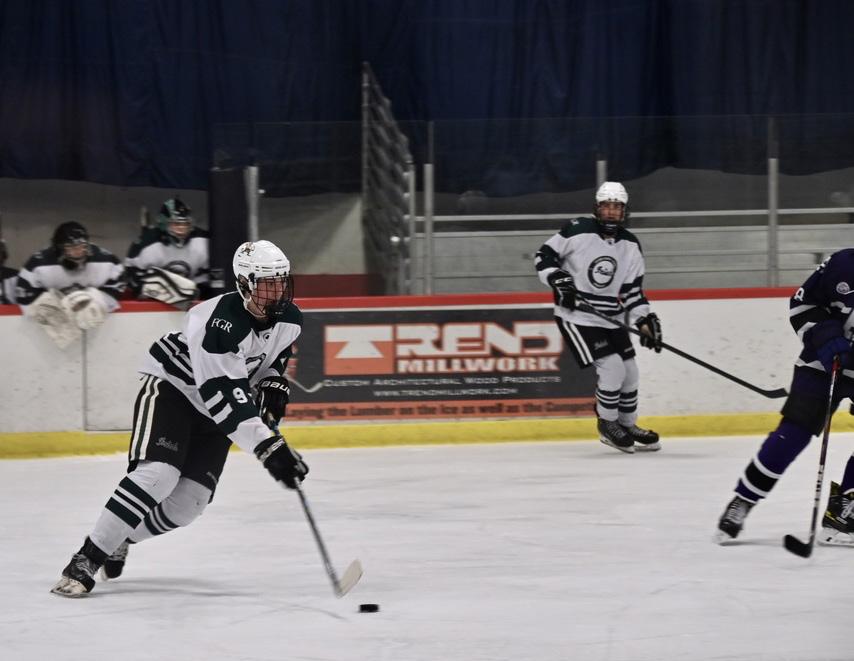
“Surprisingly, the sole reason behind the school’s buses is swimming transportation,” said Seng. “In the early 2000s, parents pushed for the school to own buses so that their kids can get to pools easier.”
The cost of sports is also dependent on student performance and the strength of the teams.
“Tennis goes way up there because they always make it to state tournaments,” said Seng. While students participate more in field, pool, ice, or court-based sports, interest has grown in other sports not offered by the school due to a lack of space and high expenses. For example, rowing, a popular sport offered by local high schools like Ann Arbor Huron and Pioneer, is not
tancing and other health guidelines regulated by the state and implemented by the school. Despite the massive increase in costs, the school’s athletic department continued to show its fluid attitude.
“We didn’t ask questions. We just did it,” said Seng.
While most costs regarding sports are predetermined and foreseen, there are costs that need to be paid throughout the season due to compliance with state and league regulations.
A rule change in 2022 demanded the athletic department to buy new, all-white jerseys for the men’s soccer team. Signs for the school’s softball diamond that warn spectators were also needed, along with new protective screens. While these costs could seem minuscule to some, they do add up, and the athletic department responds appropriately.
“You’re always going to get those unexpected things,” said Seng.
The phrase “unexpected costs” took on a whole new meaning when sports returned in 2021, still in the midst of the COVID-19 pandemic. While seasons were shortened, the total costs for sports nearly doubled due to social dis-
even later now,” said Seng. Student involvement in athletics at the school is at an all-time high, and the costs reflect that. Despite this, student satisfaction is of the utmost importance to the athletic office, and their hard work has not gone unnoticed. In 40 years,

PAGE 7
8, 2022
DEC.
Graphic by Megan Peng ‘25
Photo courtesy of David Muzzati
ICE ICE BABY Ryan Kowalchik ‘23 handles puck during the team’s 9-0 win against Ann Arbor Pioneer on Nov. 28. “I’m glad the school gives me the opportunity to play hockey,” said Kowalchik. “I know it’s an expensive sport for the school with having to rent out the rink. I’m grateful.”

Cup of Controversies
With Qatar World Cup under way, shades of gray surround tournament
NICHOLAS ALUMKAL ‘23
On a snowy December afternoon in Zurich, Switzerland in 2010, the soccer world’s governing body, FIFA, decided to award the 2022 World Cup to Qatar. This decision is both bemusing and frustrating, leaving me with questions about the lack of soccer culture in the host nation, blistering heat, Qatar’s discrimination of women and the LGBTQ+ community and worker welfare and labor laws to build the infrastructure for the tournament are also appaling.
In the 12 years since rewarding the rights and then once the tournament has begun, the world has put Qatar under the microscope, exposing the dark undertones of the host nation. I will look forward to soaking in the action on the pitch during this World Cup, but will do so with an understanding of the bribe-filled road the tournament followed to ar rive in Qatar and the atrocious treatments of minorities by the host nation. I hope you will too.
Going back to how the World Cup ended up in Qatar in the first place, it was simply illegally bought and paid for by the Qatari dignitaries. The dignitaries paid in excess of $1.5 million in exchange for the vote of com mittee members. Given the past corruption of FIFA, I’m not shocked at all about these allegations. At all. But just because the news isn’t surprising doesn’t mean it’s not important. The FIFA vote that took place in 2010 was one of the dirtiest days in sports history and sent
the world’s most popular sport down a road of corruption, abuse of power and numerous scandals. This has been proven by FIFA doubling down on the hosting rights for Qatar 2022.
Soon, the focus shifted from how Qatar got the World Cup to what it would actually take to play host to the competition. FIFA has sold its soul for a bucket of gold, at the cost of turning the entire soccer calendar on its head just to accommodate Qatar hosting the cup, changing the host date from the traditional summer slot to late autumn due to the summer temperatures ranging from 95 to 113 degrees F in Qatar.
over the last 3,000 years. Infantino does not know what it feels like to be a minority, and conflating being picked on for having freckles or negating the experience of so many minorities is absolutely astounding and tone deaf from Infantino. What also seemed noteworthy was the sheer anger Infantino displayed, on what should be a joyous moment, one day from the World Cup beginning.
Once the matches got underway, controversy continued. In the opening match, Qatar showed they could buy the hosting rights, the flashy stadiums and even the elite coaches, but the buck stopped at being able to buy victory, as the hosts lost 2-0 to Ecuador in the opener. The home fans seemed to have enough early in the game, vacating the fan section at halftime as their team trailed and put forth a poor performance. Qatar lost all three of their group matches becoming only the second host nation to be eliminated in the first round and the first not to secure a victory.
Same-sex relations are illegal in Qatar, and individuals who are found to have same-sex relations can face up to seven years in prison. Qatar said LGBTQ+ visitors would be welcome at the World Cup and fans could fly the rainbow flag at games. But “excessive” public displays of affection could face action from police.

On the eve of the tournament’s start, FIFA president Gianni Infantino erupted into a hour long monologue, getting various things off his chest with his perplexing and upsetting remarks. Infantino equated being discrimination for his red hair and freckles to being disabled, gay, or a minority race. Infantino then dismissed the human rights abuses of Qatar, noting that Western nations have had horrific human rights records
Messi to Cement legacy with World Cup win

NICHOLAS
ALUMKAL ‘23
For all his accomplishments, Lionel Messi has not won a World Cup, but in 2022, in his fifth attempt, all pieces seem to be falling into place. Messi is still the personification of nothing less than genius, leading the Argentina team as if he is conducting an orchestra, and ever so often he steps up to play a solo like only he can. If he were shown a rorschach block, he’d see goals all day long. Argentina came within feet of capturing the cup in 2014, and 2022 will be the year where the man from Argentina who is cleaner than neutrogena will hoist the trophy. Heading into the tournament, Argentina were on a 35 game win streak and had not lost since 2019. However, in their first match they were shocked, losing to lowly Saudi Arabia. This defeat proved to be the wakeup call they needed at the perfect time, as they wrote the ship the next two games to advance to the knockout stage and seem to be finding their form over the course of their play in Qatar. The x-factors for Argentina will be the supporting cast, because Messi cannot win it alone, and team spirit, a tight-knit squad with immense chemistry. Finally, Lionel Messi wins his first World Cup, giving us every reason to anoint him as the best player of all time.
Women’s rights are also strongly restricted by a male guardianship law, forcing Qatari women to obtain permission from their male guardians to get married, travel abroad, work in many jobs, receive some forms of reproductive health care and act as a child’s primary guardian, even when divorced. These laws will rightly be a worry for any women attending the tournament. The government of Qatar views women as second-class citizens at the behest of their male “guardian”, a practice that I cannot believe is accepted today, and was ignored by FIFA when choosing to give Qatar the hosting rights.
Shortly after the tournament’s start, political unrest seeped into the tournament, when Iran faced off against England. Iran is dealing with protests in response to a woman dying in custody after being detained by Iranian morality police for not wearing a hijab in accordance with regime
The words of Qatar are trying to put a good face on for the World Cup, as millions of visitors descend upon the nation for the tournament. If you are a member of LGBTQ+ community and looking to go to Qatar to enjoy soccer, it is hard to look past the idea that you are viewed as a crime and an aspect of your identity is outlawed in the country. When the tournament did arrive, it seemed as if Qatar and FIFA were not on the same page. Numerous cases of fans trying to enter stadiums were not allowed, because they had a rainbow flag, t-shirt, or even a rainbow watch strap. These fans were told they must remove their rainbow attire to enter the stadium by the Qatari security and those who did not want to were forced into detention. This further shows the planning and coordination between FIFA and Qatar has been as sloppy as a soup sandwich, and the individuals who were refused entrance were forced into an uncomfortable situation when none should have occurred. If this is the World Cup, imagine how difficult it must be for ordinary Qataris who might wear a rainbow shirt when the world isn’t watching.
standards. In Iran’s first match, with the whole world watching, the Iranian players did not sing the anthem, instead standing arms around one another, stone faced and silent in an act of solidarity with the women grappling with their basic rights in the home nation. As the anthem played over the loudspeaker in the stadium, the soundtrack was interrupted by boos from the Iranian supporters. In another case of strict security crackdown in Qatar, Iranian fans have not been able to wear or protest messages supporting women in Iran. With the World Cup finally here, and the building of highways, sidewalks, skyscrapers, and stadiums all complete, millions of foreigners descend upon Doha to bring in large sums of money for Qatar’s economy. The lesson FIFA must learn from Qatar ‘22 is to not allow pariah states to host major tournaments. Instead of backing these nations, FIFA must repudiate the discrimination of minorities and outdated laws and not be swayed if bribes are dangled looking for FIFA to bite. The World Cup should be a moment where we celebrate the diversity of the globe, not victimize those who may be different from
us.

On all accounts, The Qatar World Cup has done the opposite.
The Three Lions to Hoist the World Cup

DEVYN MCGOW ‘23
England has advanced to the quarterfinals of the 2022 World Cup and is my pick to hoist the World Cup Trophy when the tournament ends. England will next face France in the quarterfinals, which is historically significant as the countries have battled on and off the pitch for centuries. England has the experience and drive to win this tournament with a team made up almost entirely of players from the top level of English soccer, the Barclay’s Premier League, which is regarded as the best professional league in the world. England almost won their last international tournament in 2020, by advancing to the Eurocup
2020 finals, losing to Italy on the penalty kick tiebreaker. Their team is battle-tested in major international tournaments and they also have extra motivation to win the championship after their near miss in 2020. England has scored the most goals in the first three rounds of this World Cup with nine goals, tied with Spain. Defensively they have been rock solid, giving up only two goals in the first four games. They have the offensive firepower and defensive strength to win the World Cup. Their talent, experience, and hunger to win will propel them to victory in Qatar.

Turning field into dance floor, Samba Kings ready to get crowned

FIONA LIN ‘23
With five titles secured, the Brazilian team holds the record for most World Cup victories. The chase for the sixth will not be an easy one, but there is no doubt that they can do it again.
On Dec. 6, the Brazilians crushed South Korea in a romp. As forward Neymar Junior returns for the quarter-finals, the team no longer suffers from Neymardependência, which wasn’t even bad to begin with. Even without its star player, the Brazilian team has been consistently strong and fierce. Forwards Vinicius Junior and Richarlison, midfielders Fabinho and Casemiro, defender Thiago Silva, and goalkeeper Alisson Becker – the team is stacked in every

position. The Seleçâos are known for their unique style in possession, which ensures that players occupy each of the five attacking channels. This strategy opens up opportunities for the offenders to shine.
Neymar, just like Pelé, is vying for a World Cup title, but success for the Canary Squad is more than just him. Neymar is the cherry on top, but we’ve all seen Brazil thrive without him: the team made it through the knockout stage strong after defeating Switzerland 1 – 0. Following France and Portugal’s path, the team went easy on the last group stage game after qualifying; their loss against Cameroon is nothing to worry about. Brazil is ready to bring home the big trophy.
Répéter: France could be back-to-back World Cup winner

CHAKOR RAJENDRA ‘23
Four years ago the streets of Paris erupted in collective jubilation as the referees blew their whistles signaling the end of stoppage time and declared the French the World Cup winners over rival team Croatia. Fast forward to today and the French are hoping to defend their title. I think through their experience and star power the repeat will happen.
The French national football team, or Les Bleus as they are also known, are led by international star Kylian Mbappé. He is the top scorer so far in the 2022 Qatar World Cup with five goals.
A young energetic player known for his skill and creativity, has all the tools to lead his team back to
the championship trophy. Coming out of the group stage as the top team in Group A (after beating Australia and Denmark and narrowly losing to Tunisia), they dismantled Poland 3-1 in the round of 16. They face England in the quarter finals where they are the favorites(according to the betting odds). If they were to defeat Harry Kane and the English, they would face either a Moroccan team who upset the Spanish favorites in penalty kicks or a Portuguese powerhouse led by all time legend Christiano Ronaldo. France has all the tools to come out on top and will hoist the trophy once more in Qatar.
PAGE 8 DEC. 8, 2022
Graphic by Megan Peng ‘25
Graphic by Megan Peng ‘25
Graphics by Mustafa Zirapury
‘23
























































